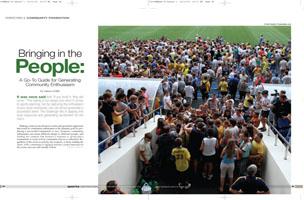
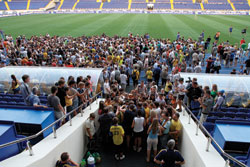 |
| © Iurii Osadchi - Dreamstime.com |
It was once said that "if you build it, they will come." That saying is not always true when it comes to sports planning, but by capturing the enthusiasm of your local community, one can all but guarantee a successful event. The challenge lies in tapping into local resources and generating excitement for the event.
Making connections between events and potential supporters that result in community enthusiasm is the ultimate goal for producing a successful tournament or race. However, community enthusiasm can mean different things to different people, and finding the common link between a business or group and a tournament or event is how community buy-in is cultivated. Regardless of the event or activity, the location, or those leading the effort, if the community is engaged and has a vested interested in the event, success will usually follow.
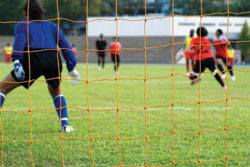 Gaining the assistance of the local convention and visitors bureau or sports commission is the first step in garnering the attention of the community. The local CVB or sports commission should be the event planner's liaison to community leaders, volunteer groups, and businesses. There are a few key things that a sports planner should do when garnering the support of the CVB/sports commission. First, be very blunt about the bid fee for the event. How much is needed in order to hold the event in their town. If the CVB/sports commission shows concern regarding the amount of the bid fee, look into the possibility of the CVB/sports commission paying a portion and then securing sponsors for the rest of the bid fee. Secondly, know the event's history. How many room nights were generated in the past and what economic impact the city can expect. If the possibility exists that the event could become an annual event,the tournament or race becomes even more attractive. If the planner can show a respectable return on investment, they are likely to win the support of the CVB/sports commission.
Gaining the assistance of the local convention and visitors bureau or sports commission is the first step in garnering the attention of the community. The local CVB or sports commission should be the event planner's liaison to community leaders, volunteer groups, and businesses. There are a few key things that a sports planner should do when garnering the support of the CVB/sports commission. First, be very blunt about the bid fee for the event. How much is needed in order to hold the event in their town. If the CVB/sports commission shows concern regarding the amount of the bid fee, look into the possibility of the CVB/sports commission paying a portion and then securing sponsors for the rest of the bid fee. Secondly, know the event's history. How many room nights were generated in the past and what economic impact the city can expect. If the possibility exists that the event could become an annual event,the tournament or race becomes even more attractive. If the planner can show a respectable return on investment, they are likely to win the support of the CVB/sports commission.
Once the CVB/sports commission is on board, the relationship building with the community begins. One way to ensure community involvement is to get local charities involved and invest in those charities. A great example of this is recruiting charities to sell tickets for the sporting event and allowing them to keep a portion of the proceeds from the ticket sales. Or incorporate a charity component in the event. For example, if the event is a baseball tournament, designate one day as a charity benefit, and allow businesses to pay to play with those dollars going to the charity. Make a deal with the charity that they will, in turn, provide volunteers for the event. By doing this, organizers demonstrate to the local population that the event is giving back to the community.
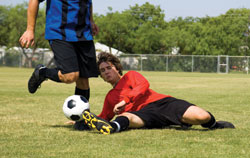 When seeking volunteers for an event, one can also tap into local businesses and not just charities. Some companies require their employees to give a certain amount of volunteer hours to local organizations throughout the year. Associates are able to choose events that are close to their hearts or hobbies and give of their time as a representative of their company. Within every company, there is someone who is a soccer fanatic, a mountain bike junkie, or a religious runner. Tap into these interests to gain support for sporting events.
When seeking volunteers for an event, one can also tap into local businesses and not just charities. Some companies require their employees to give a certain amount of volunteer hours to local organizations throughout the year. Associates are able to choose events that are close to their hearts or hobbies and give of their time as a representative of their company. Within every company, there is someone who is a soccer fanatic, a mountain bike junkie, or a religious runner. Tap into these interests to gain support for sporting events.
In addition to volunteerism, planners are usually in need of sponsorship dollars. Breaking into a new market can be challenging; however, one tactic that shows local businesses that the event has community support is to take someone from the convention and visitors bureau or sports commission on sales calls when asking for dollars. It adds credibility to the event and helps build those business relationships faster.
Tapping into the interest of local leaders can also prove valuable for garnering community enthusiasm. Find out what sports interest local leaders and bring those events to that town. For example, if the mayor of a town is a tri-athlete, bring in a triathlon and give the mayor a complimentary entry. Promote his or her involvement throughout the city or region. Locals will come out just to see the mayor compete and businesses may be more apt to give sponsor dollars if a local elected official is involved.
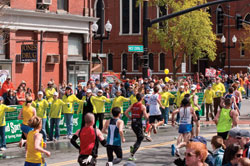 |
| When seeking volunteers check with local businesses. Some companies require their employees to give a certain amount of volunteer hours to local events throughout the year. |
Organizers should also consider implementing a corporate challenge element into an event that will spur local businesses to compete against each other. This will not only bring in additional dollars for the event, but also involve key leaders in the community who will have friends, family and employees attend the event just to see them perform.
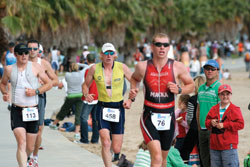 |
| Photo © max blain - Dreamstime.com |
Incorporating family-friendly elements into sporting events will also generate community enthusiasm. If an event is mostly geared toward adults, create a fun zone with bounce houses or inflatable obstacle courses and games just for kids. Spectators can come out to view the event, and have something to keep the little ones busy. Better yet, incorporate a fun run or kid's only race where toddlers can compete just like mom or dad. Make sure you have medals, ribbons, or trophies to give the kids at the finish line. Avoiding tears because a little one did not receive a medal like mom's or dad's is worth the small investment. Encouraging young ones to get involved in sports is, after all, what perpetuates the life expectancy of sporting events year after year.
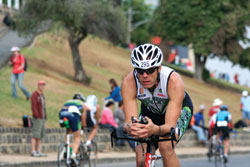 |
| Photo © max blain - Dreamstime.com |
Another beneficial relationship that a sports planner should cultivate in a city is with the local parks and recreation director or high school athletic director. The majority of sports events use city or school facilities and developing a friendship with the local parks director or athletic director can be a win-win for the event as well as for the community. A way to do this is to give something back to the parks or schools to show appreciation for their support. For example, incorporate a "green day" either before the tournament or after the tournament where kids and families sign up to re-skin a local basketball court, help plant trees, or install new playground equipment. The planner may even consider giving those that sign up for the green event a discount on their registration fee as an incentive to participate. The parks department or athletic complex may be willing to waive field fees if the planner organizes a green event or clean up day for the facility in use.
If an event does incorporate something that gives back to the community, spreading the word is key to building community enthusiasm. To do that, the sports organizer needs to tap into an assortment of traditional and non-traditional media. Forming partnerships with local media outlets is invaluable. TV, radio and newspaper are still great avenues for communicating with the public. Submitting press releases to these local media outlets promoting opportunities for the community to become involved can result in many volunteers and businesses contacting the event planner to help instead of the planner having to hit the pavement and beg for support. Local news stations always need feel good pieces to end their broadcasts, and introducing them to the charity or green component of an upcoming event is an easy way to get free advertising or publicity that will generate community enthusiasm.
 Social media is also a must for creating a buzz in the community about a race or tournament. Create a Facebook page not only for the national organization, but also for the local event to disseminate information quickly to event attendees. Twitter, text messaging and e-blasts can also be useful tools for getting the community involved. Local chambers of commerce usually have email lists of local businesses that can be purchased and then used for e-blasts. Furthermore,tap into local clubs that will likely participate in the event, and have them send out emails or texts about the event to grow interest.
Social media is also a must for creating a buzz in the community about a race or tournament. Create a Facebook page not only for the national organization, but also for the local event to disseminate information quickly to event attendees. Twitter, text messaging and e-blasts can also be useful tools for getting the community involved. Local chambers of commerce usually have email lists of local businesses that can be purchased and then used for e-blasts. Furthermore,tap into local clubs that will likely participate in the event, and have them send out emails or texts about the event to grow interest.
One great way to obtain free publicity for an event that will spur community enthusiasm is to get a local TV or radio personality involved in the event. For example, if the event requires extensive training like a marathon or triathlon, find a local news anchor or disc jockey that is willing to begin a training program that he or she can talk about on the local news or radio broadcast. The anchor or disc jockey can keep a video journal of their experience that they can share via live broadcast or on the stations local website. They may also be able to recruit team members to train with them, thus involving the community, growing enthusiasm for the event and boosting registration numbers.
If an event is labor intensive, one of the best ways to gain community support is to create committees to handle different aspects of the event. This provides leadership opportunities for locals looking to boost their resume or simply have a vested interest in assuring the success of an event that may be close to their hearts. Advertise or submit press releases to the local paper and TV stations for a call for committee members. News outlets needing filler stories will often post "call for volunteers" announcements.
Tournaments or races that have the potential to become annual events have a better chance of generating community buy-in than those that only come around every so often. Communities like to make things their own, and if the planner presents an event that the community can get behind, the likelihood of that event succeeding and growing year after year is extremely high. Not to mention that the local convention and visitors bureau or sports commission enjoys having events that they can depend on yearly to generate tax dollars so that they are not constantly going after new business.
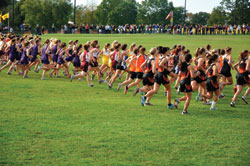 Furthermore, CVB/sports commissions are encouraged by the community and their boards to bring in new events while nurturing existing ones. If an event will contract with the CVB/sports commission for a certain number of years while the event is in its infancy, and if the organizer demonstrates how it will wean itself away from needing the bureau's financial support and simply leaning on them for in-kind or personnel, planners have a greater chance of securing initial support of their event. When an event proposes that it will eventually become self-sustaining, the CVB/sports commission immediately knows that this will free up future dollars for new events. However, the bureau or commission must, in turn, promise to put forth the effort to connect the sports organizer with community leaders and businesses in order to ensure the longevity of the tournament or race.
Furthermore, CVB/sports commissions are encouraged by the community and their boards to bring in new events while nurturing existing ones. If an event will contract with the CVB/sports commission for a certain number of years while the event is in its infancy, and if the organizer demonstrates how it will wean itself away from needing the bureau's financial support and simply leaning on them for in-kind or personnel, planners have a greater chance of securing initial support of their event. When an event proposes that it will eventually become self-sustaining, the CVB/sports commission immediately knows that this will free up future dollars for new events. However, the bureau or commission must, in turn, promise to put forth the effort to connect the sports organizer with community leaders and businesses in order to ensure the longevity of the tournament or race.
The success or failure of events can be directly tied to community involvement or lack thereof. There must be a connection for people to get involved, and more often than not that duty falls on the local convention and visitors bureau or sports commission to build that bridge between community and event. Sports planners should depend on their local CVB/sports commission to get them involved in the community. Because community enthusiasm means different things to different people, finding that common link between a business or group and a sporting event is the key to securing community buy-in. No matter the sport, the location, or even those organizing the event, if the community engages and shows a vested interest, the success of the event will follow.

